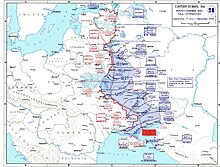
Back معركة سمولينسك (1943) Arabic Битка при Смоленск (1943) Bulgarian Batalla de Smolensk (1943) Catalan Operace Suvorov Czech Slaget om Smolensk (1943) Danish Smolensker Operation German Batalo de Smolensko (1943) Esperanto Batalla de Smolensk (1943) Spanish Smolenskin taistelu (1943) Finnish Bataille de Smolensk (1943) French
| Second Battle of Smolensk | |||||||
|---|---|---|---|---|---|---|---|
| Part of the Eastern Front of World War II | |||||||
 Map of the Smolensk operation and related offensives. | |||||||
| |||||||
| Belligerents | |||||||
|
|
| ||||||
| Commanders and leaders | |||||||
| Günther von Kluge |
Andrei Yeremenko Vasily Sokolovsky | ||||||
| Strength | |||||||
|
Soviet estimate: 850,000 men 8,800 guns 500 tanks 700 aircraft[1] |
1,252,600 men[2] 20,640 guns 1,430 tanks 1,100 aircraft[1] | ||||||
| Casualties and losses | |||||||
|
German medical data only:[3]
|
Soviet sources: 451,466 overall (~350,000 in combat) (including 107,645 killed, missing or captured 343,821 wounded and sick[2]) | ||||||
The second Smolensk operation (7 August – 2 October 1943) was a Soviet strategic offensive operation conducted by the Red Army as part of the Summer-Autumn Campaign of 1943. Staged almost simultaneously with the Lower Dnieper Offensive (13 August – 22 September), the offensive lasted two months and was led by General Andrei Yeremenko, commanding the Kalinin Front, and Vasily Sokolovsky, commanding the Western Front. Its goal was to clear the German presence from the Smolensk and Bryansk regions. Smolensk had been under German occupation since the first Battle of Smolensk in 1941.
Despite an impressive German defense, the Red Army was able to stage several breakthroughs, liberating several major cities, including Smolensk and Roslavl. As a result of this operation, the Red Army was able to start planning for the liberation of Belarus. However, the overall advance was quite modest and slow in the face of heavy German resistance, and the operation was therefore accomplished in three stages: 7–20 August, 21 August – 6 September, and 7 September – 2 October.[5]
Although playing a major military role in its own right, the Smolensk operation was also important for its effect on the Battle of the Dnieper. It has been estimated that as many as 55 German divisions were committed to counter the Smolensk operation – divisions which would have been critical to prevent Soviet troops from crossing the Dnieper in the south. In the course of the operation, the Red Army also definitively drove back German forces from the Smolensk land bridge, historically the most important approach for a western attack on Moscow.
- ^ a b A.A. Grechko and al., History of Second World War, Moscow, 1973–1979, tome 7, p.241
- ^ a b Glantz (1995), p. 297
- ^ "1943". Archived from the original on 25 May 2013. Retrieved 13 March 2014.
- ^ V.A. Zolotarev and al., Great Patriotic War 1941–1945, Moskva, 1998, p 473.
- ^ Robert Forczyk, Smolensk 1943: The Red Army's Relentless Advance, Osprey Publishing, Oxford, UK, 2019, Kindle ed.
© MMXXIII Rich X Search. We shall prevail. All rights reserved. Rich X Search